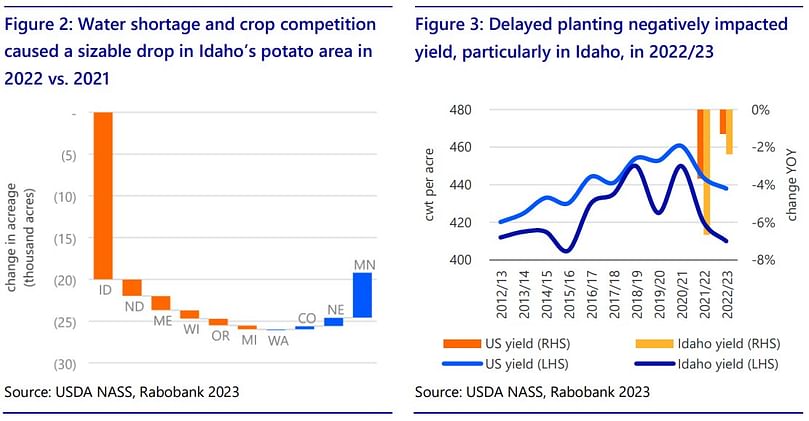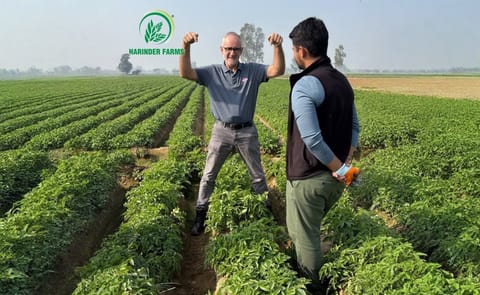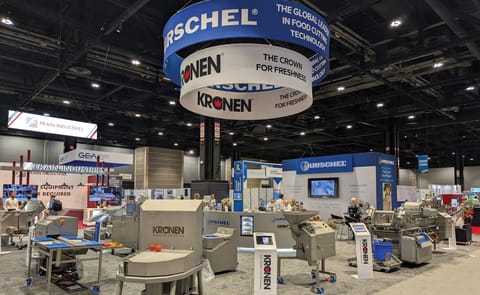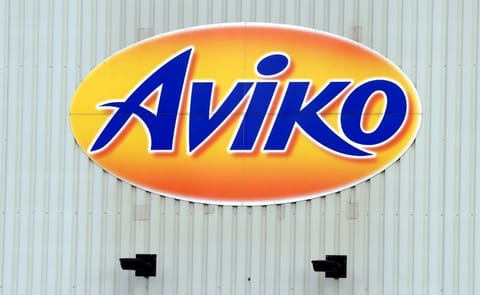US potato production area break records lows 2000/01 - 2022/23
US Potato Prices Expected to Ease but Stay Elevated according to Rabobank Report
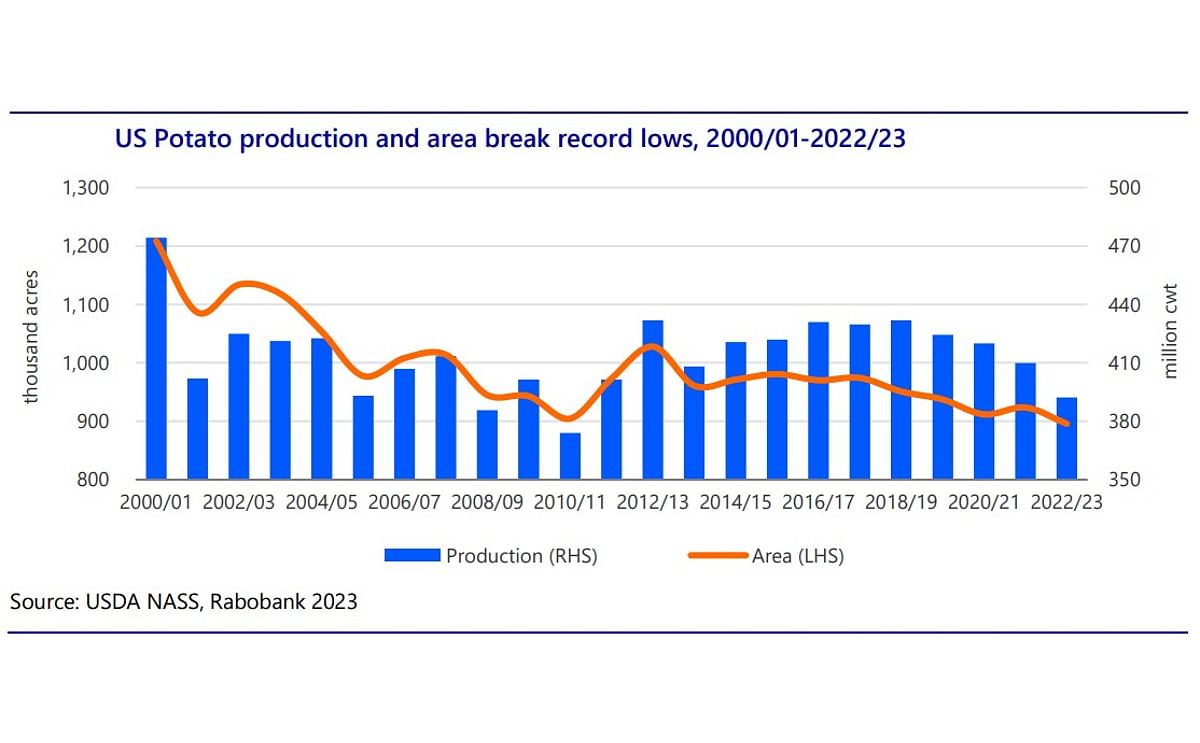
Rabobank has released its report on the United States’ potato industry - US Potato Outlook 2023/24: After a Record-breaking Year, What Is in Store for US Potatoes? The report notes that the US potato production has been the lowest since 2010, registering the fourth consecutive decline. Coming at a time when consumers’ purchasing power is hit by high inflation, potato has a special significance.
In view of the low production, potato prices in the open market surged to new highs. Demand for frozen potatoes also grew, creating a high price environment overall.
Anticipating potato plantation area to grow by 2% YOY given the high open market and contract price environment, the report anticipates a 7% drop in price in 2023-24 marketing year. Processors who have been hit by low supply over the past two seasons are more willing to offer higher contract price.
Consumers who will have to pay a higher price for fresh potatoes, French fries, and other frozen potato products are unlikely to reduce their consumption of these products, the report prepared by Almuhanad Melhim, Analyst – Fruits, Vegetables, & Tree Nuts, said. This year, production decreased due to a significant drop in Idaho's potato-growing area and below-average yield. In addition, widespread water shortages reduced planted acreage and yield.
Competition from other crops and delayed planting also contributed. Growers' uncertainty about water availability and allocation, based on senior and junior water rights, increased production and contract risks. As a result, risk-averse growers with junior water rights chose crops requiring less irrigation and avoided contract production.
Potato prices surged to a record high, with growers receiving nearly USD 13/cwt on average, up 26% YoY and 36% above the five-year average. Escalating demand for frozen potato products In the last two years, there's been a remarkable recovery in the demand for frozen potatoes. As a result, the sales of frozen products in the food service industry experienced impressive growth rates of 30% in 2021 and 10% in 2022, surpassing pre-Covid levels.
However, this increased demand for frozen potatoes has coincided with a decline in production, leading to a scarcity of these products. As a result, a higher percentage of potato production has been allocated to meet the average use of frozen potatoes. This scarcity has prompted a significant rise in imports, reaching the record highest net import position for frozen and fresh potatoes.
Importers have sought cheaper frozen potatoes in global markets to meet the strong domestic demand. Similarly, the import of more expensive fresh potatoes has also increased to compensate for the shortage within the country.
Contract Prices on the Rise: Favorable Conditions for Growers Open market prices and high demand for frozen potatoes have led to an increase in contract prices. Processors perceive the strong open market prices as a signal that growers have less motivation to switch from producing fresh potatoes for the open market to producing potatoes for processing under contract.
On the other hand, the robust demand indicates favorable market conditions for expanding the production of finished products. Furthermore, there has been unmet demand for potatoes produced under contract for two consecutive years.
Despite a 20% to 25% year-on-year increase in contract prices for the 2021/22 marketing year, the market was not cleared, resulting in a supply deficit. Large fryer companies, like McCain Foods, Lamb Weston, and J.R. Simplot Company, had to source raw potatoes from other regions to partially offset regional deficiencies, as they had expanded processing capacity in the Pacific Northwest before the Covid-19 pandemic.
This additional capacity is expected to be increasingly utilized soon, as the demand for french fries and other frozen potato products has recovered to or even surpassed pre-pandemic levels. The significant production decline in the Pacific Northwest processing region is partially compensated by sourcing inventories from other regions with better supply situations.
As a result, fryers have passed on the increased cost of procuring raw potatoes to retail consumers without experiencing a loss in revenue. Consumer purchases of frozen potatoes have shown minimal sensitivity to price increases, indicating inelastic demand.
Consumers consider these products essential and have maintained their demand despite higher prices, as frozen foods with longer shelf lives are viewed as a means of maintaining a healthy diet while hedging against price inflation.
This trend has benefited various food categories, including fries and other frozen potato products. Fryers have successfully passed on the high cost of raw inventories to consumers without suffering a decline in sales.
These factors create a strong economic incentive for fryers to offer growers attractive contract terms. This ensures an adequate supply of raw potatoes, avoids costly idle capacity, and prevents the loss of revenue from retail sales in a high-demand environment. Potato growers historically respond to low production and high prices by expanding their acreage.
However, factors such as non-price contract terms, input costs, alternative crop prices, crop rotation, water constraints, and seed availability influence the relationship between price and the planted area. For the upcoming 2023/24 marketing year, competitive potato prices compared to alternative crops and an improved water outlook are expected to increase potato planted areas.
Moreover, concerns about negative impacts on soils and environmental stresses may lead growers to avoid repeating last year's crops. Considering all these factors, the acreage response to price alone would result in a substantial 11% year-on-year increase to approximately 990,000 acres.
However, accounting for other factors and trends, they anticipate a more modest 2% year-on-year increase to around 915,000 acres. The report anticipates good prices for the remainder of the 2022/23 marketing year, particularly as the year comes to an end before the new crop harvest begins.
Assuming average yields and the expected increase in acreage, they expect a 7% year-on-year drop in the annual grower's price for all potatoes.
However, there is a high upside risk due to unseasonably cold weather in most producing regions, which could delay planting and negatively impact yields. Therefore, despite the projected decrease, potato prices will still be considered high compared to historical levels.
Conclusion The current marketing year has been favourable for independent potato growers, with open-market potato prices increasing twice as much as contract prices.
This strengthens growers' bargaining position for negotiating contracts in the upcoming year. However, record-high prices may not be sustainable if production levels and planted area increase. Processors will likely pay higher contract prices to meet food service and retail demand.
Consumers are expected to continue paying high retail prices for potatoes, as they are willing to increase consumption despite weakened purchasing power. In summary, potatoes remain in high demand despite being scarce and expensive.

